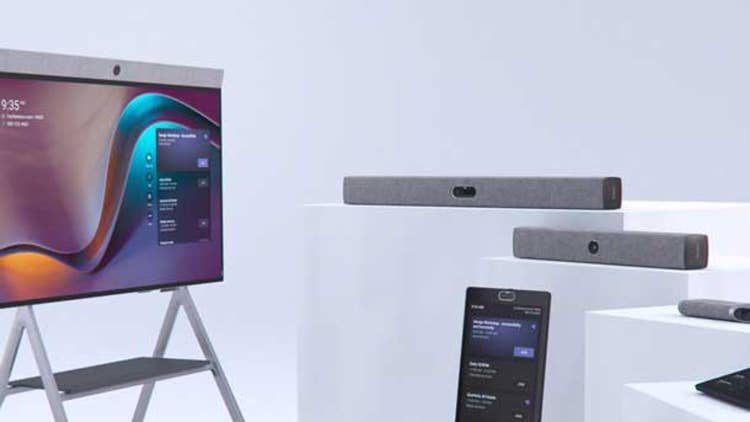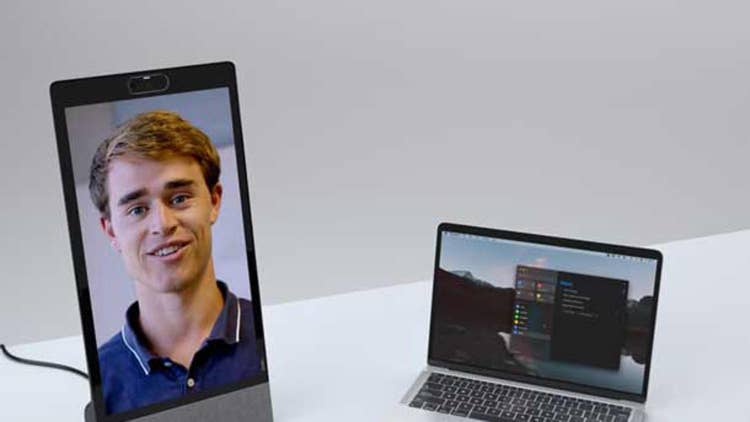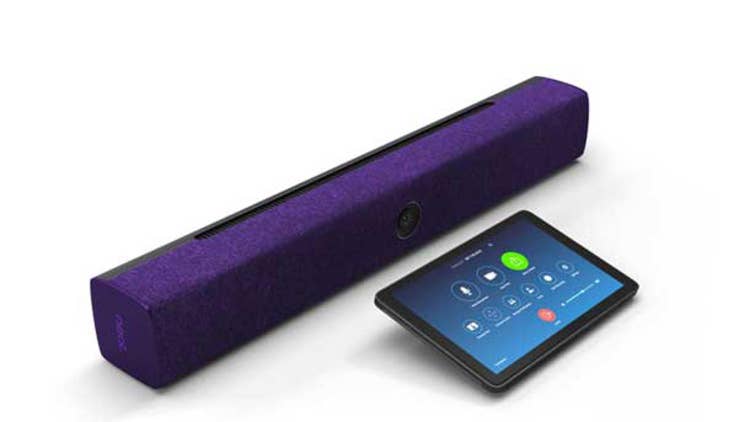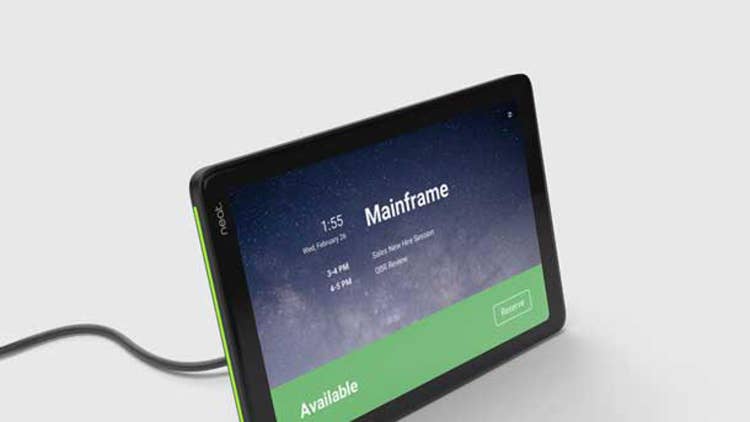Norwegian Startup Neat Aims To Take Zoom, Microsoft Teams Meetings ‘To The Next Level’
‘We really started this company to take this industry to the next level and really deliver the best experience with Zoom. So we really worked very closely with Zoom on the engineering side, the product development side, as well as the market side, to deliver on that,’ says Neat CEO Simen Teigre.

Making Channel Play For Zoom, Teams Equipment
Oslo, Norway-based Neat is a startup founded to develop advanced equipment for making Zoom meetings easy. And in less than two years, the company, which counts Zoom as an investor, has sold over 40,000 of its Neat Bar conference cameras and display controllers, Neat Pad touch-screen controllers and Neat Board 65-inch displays with built-in camera and audio, primarily in the U.S.
Neat last month signed a deal with Microsoft to let its equipment run with Teams as well, and could expand to include Google Meet or Cisco WebEx, CEO Simen Teigre told CRN. Just as important, the company this week is going big with its channel program, adding new elements and its first distribution partners, in order to grab its share of solution providers helping enterprise clients take advantage of the latest Internet-based conferencing technology.
Teigre said simplicity is a hallmark of Neat’s technology. But when it comes to companywide conferencing needs, businesses will turn to their solution providers. “You couldn’t do the kind of installations that customers now require with old technologies,” he said. “It would be too complicated. The simplicity of our product really enables partners to scale this in a profitable way.”
Teigre also gave CRN a little peek at some upcoming enhancements to the Neat product family.
For a look at a fast-growing, channel-focused company and its plans to be ready for the future of Internet-based video conferencing, click through the slideshow.

Tell us a little about Neat.
Neat was started in February 2019 and launched in October 2019 to build Neat devices, as we call our video devices, to provide the best meeting experience for Zoom. [When] the pandemic hit in March, we were wondering it would impact video room equipment [sales] when everybody was at home. Well, we’ve had tremendous growth through 2020. We beat our original business plan by four-times, and going into 2021, we’ve had tremendous, tremendous momentum. We just recently announced that we will expand our partnerships beyond Zoom, and added Microsoft to our portfolio partners on the platform side, which means that customers can now get Neat devices for either Zoom or Microsoft Teams. We’re a global company. We started in Norway. That’s where our engineering headquarters is. But the U.S. is really our biggest market. Since we started this company together with Zoom, we really have been following their success.

Who are your investors?
The two lead investors are Fredrik Halvorsen, the former CEO of Tandberg, a pioneer in video conferencing, and [Tandberg’s former Executive Vice President of Products] O.J. Winge. He was at Tandberg, running the product side, and also was a Cisco senior vice president for collaboration back in the day. So these two guys are the lead investors. And then we also have Zoom as an investor, and they made an investment in a couple of rounds. They made the first investment as we launched in October 2019 with them. And then of course, employees and the co-founders, myself included.
How important was that investment from Zoom?
That’s been very important for us from a strategic perspective. It’s a minority state, and we wanted to bring them in as an investor because it shows our joint commitment as partners to work together. So that’s why it was important for us to have that with our launch in October 2019. It was also important for Eric [Yuan, Zoom CEO] and the Zoom team to show their commitment to us as a new player and a new partner. Like I said, we really started this company to take this industry to the next level and really deliver the best experience with Zoom. So we really worked very closely with Zoom on the engineering side, the product development side, as well as the market side, to deliver on that.
You mentioned that you’ve just recently signed an agreement with Microsoft on Teams as well to provide integration with Neat. Did the fact that Zoom is a big competitor to Teams impact the decision to partner with Teams?
I would say that it’s basically a result of listening to our customers. As a small company, it’s important to focus, and we wanted to start off with Zoom, and we had a very close relationship. And we still do. But we’ve been asked over and over again by customers to also support Microsoft Teams, which is the other big player in this market. So from our perspective, it’s really important to listen to our customers and deliver Neat to any customer, depending on whether they have Zoom or Teams. And this is the same strategy that Zoom has. They have an ecosystem of partners, and they’re working with many other partners in the industry.

So you started off with Zoom, and you’ve just brought in a relationship with Microsoft Teams. How about future relationships with say Google Meet or Cisco WebEx? Any plans to expand?
If you look at cloud-connected video rooms, Microsoft and Zoom have about 75 percent of market. But I would not preclude us working with other partners as well. But we want to make sure that we deliver a great quality solution to our customers. That’s why we focused on Zoom initially and on making sure that is a tight and delightful experience. And now we’re doing the same thing with Microsoft to make sure that the Teams experience is great on our devices as well. We’ll see in the future what happens with other potential partnerships.
When will the Teams connectivity be available for the market?
That’s in process now. We’re working on certification with Microsoft. We will have products supporting that by the end of the year. It’s going to be a software upgrade for all of our products, and the customer could then choose if they want to buy Neat devices for Zoom or Neat devices for Teams. And then it’ll be available on the Neat Bar, which is [our] best-selling product, as well as the Neat Board. And then we’re also bringing out a number of new products. These are the Neat Bar Pro, the bigger brother of the Neat Bar, as well as the Neat Frame, a personal device, and Neat One, a video peripheral for the PC, later this year. And all of these products will also be certified to support Teams.
Will the hardware be able to switch between Zoom and Teams with just a flick of a button or something?
It’s basically something the IT administrator would do. You set the system up in the Zoom mode or Teams mode and then you run the room in that setting. It’s not something you can flip between meetings, but it’s something that you do as you set the system.

What’s unique about Neat? What’s the key differentiator here?
I think the key differentiator Is that we have built a very, very high quality and simple product. When I say simple, I mean it’s very simple to install the devices, meaning that anybody can really get the product and set it up. You don’t have to be an IT specialist to do it. It’s a very simple and powerful value proposition from that perspective. That also means it’s a highly scalable product for enterprises. Especially now during times of COVID. When our enterprise customers want to deploy hundreds of Neat devices around the world to get ready to come back to office, they need a very simple and scalable product to be able to do that.
And we have a lot of innovations. My favorite is probably what we refer to as Neat Symmetry, which is basically the ability to focus in on individuals in the room and bring them forward and Zoom in all automatically so you don’t have to fiddle around with camera controls and stuff like that. But we also have other innovations as well around sensor capabilities, improved audio capabilities, et cetera. And I think from a channel perspective, we started out developing this product so that anybody could use it and install it and get it up and running. But with the pandemic, we’ve seen that it’s a crucial thing to have a simple product that you can scale. Our customers now want video capabilities in all of their spaces, not just the conference rooms, but in open spaces, in their lobby, in their kitchen, coffee area, lounges, et cetera. And I think if you want to scale these deployments with customers, then it’s important that the product is very simple and reliable. So I think it’s a great opportunity for our channel partners to be able to scale this profitably.

When somebody refers to a product as being very simple to install and use, that typically sounds more like a consumer product than it does something for the B2B channel. Where does the channel come in, and where can partners profit on this?
If you want to buy a single Neat Bar, you can probably set that up yourself. But when you want a few more, it becomes a bit of a project. It’s simple, yes. But what we’re seeing is that when customers want 10 Neat devices, 20, 50, a hundred, and they want it across multiple locations and even across multiple geographies internationally, they want to buy this through their channel integrators and resellers. I think the value here for the channel partner is that the simplicity and the reliability of the product means you could scale this in a different way. You couldn’t do the kind of installations that customers now require with old technologies. It would be too complicated.
The simplicity of our product really enables partners to scale this in a profitable way. I usually use the example of, if you take this office space, I have ordered more desks for employees because we’re growing fast. Desks are very simple to assemble. But I’m not asking my engineers to assemble these desks. That’d be a waste of their time. I’m buying these from a partner that can take care of the whole delivery and installation and all of that stuff. It’s the same thing with Neat products. Customers want this taken care of by resellers, the whole project managed, the whole installation taken care of, and of course supported in case something happens. So we’re seeing customers big and small ... where we’ve had tremendous success. More than half of our business is in large enterprises. They naturally want this delivered through their selected partners, but even smaller customers also want that. So we’ve done that from day one.

How big is your North America business? Can you quantify that at all?
Well, we’re not sharing numbers as such, but I can say that we’ve shipped 43,000 devices in one-and-a-half years. And 70 percent of that business has gone to North America.
When I say devices, that’s the Neat Bar and the Neat Pad and the Neat Board. Those are the three products we’ve been shipping and are shipping. We added the Neat Board in October last year. So it’s been amazing. The U.S. is clearly our biggest market and where we have the most traction, but we’re also growing very fast across the globe.
What part of your revenue goes through indirect channels?
The majority of our business is going through the channel. We launched our channel program in October last year. But even prior to that, we were working with channel partners to fulfill our customer requirements. We closed our first enterprise deals in February of 2020 when we first started shipping our product. So we’ve been working with the channel unofficially all this time. We made it official in October last year. And now we’re extending it again to include distribution partners as well. We’ve had tremendous success with the channel. Our customers are asking to get their Neat products through the channel and be supported and serviced by the channel. This is something that we are doubling down on now.
We’ve had tremendous growth, as I said. But we also see that if we really want to scale this business, the way to do it is with a channel-first strategy. Channel is in our DNA. I mean, our founder, the former CEO of Tandberg, was all channels. And O.J. Winge, who was also running products. I was at Tandberg. All of the stuff I’ve done at Tandberg, Cisco, all channels. I started Pexip and ran that company as CEO. Pure channel model. ...
Last year when we launched our channel program, we brought on-board an old friend and a good colleague of ours, Rick Snyder, who did global channels for Cisco for many years. He also worked at Tandberg with us back in the day. We brought him on our board of directors to help us with our channel strategy. So we’re fully committed to that. [Channels are] all we’ve done our entire careers and that’s our number one opportunity now to grow this business.

Can you talk about your biggest deal so far, even if you can’t say the customer name?
We have several large deals. The banking and financial sector is a very interesting one. We have several of the largest banks in the world who are some of the largest customers on Zoom, and they have standardized on Neat devices for their office spaces and have deployed hundreds and hundreds of Neat Bars and Neat Boards around the world. This has been a very, very exciting and interesting challenge for us because they want to deploy the devices in 30, 40-plus countries around the world.
One of your customers is the President and Vice President of the United States, right? Can you talk about that deal and how it happened?
It’s really exciting of course to be selected by the President. And especially in these times to be able to support his efforts to with Operation Warp Speed and everything that’s going on in the Oval Office. It’s really a close collaboration with Zoom, our channel partners, and the White House, making sure that they have Neat products to support them. They have a Neat Board in the Oval Office. We can actually see it in official photos and videos coming out of there.
Who was the channel partner who did that deal?
I’m not sure I’m at liberty to disclose any details.

What’s the competitive market for your products? Who is Neat competing against?
I think our main competitors are probably Logitech and Poly. Having said that, though, the market is growing so fast now and demand for devices is so strong that what’s really constraining us is not the competition. The tides are rising, and all boats are rising with the tides. And we’re all in this space to do our best to support our customers with the scale they need for video devices.
Are you working with any distributors in North America?
We’re signing with Midwich Group and their subsidiary in the U.S., [Chesterton, Ind.-based pro A/V distributor] Starin. And we’re also going to be announcing additional distribution partners in the future as well. And we already have a long list of partners that we’ve been working with for a while. CDW is one of our largest partners. We have Anixter, we have SHI, DGI, Insight, Presidio, and a bunch of international partners across the globe. So it’s already a pretty strong channel business, but that’s where we want to double down. With opening up our global channel program with distribution partners, we can expand that even further.